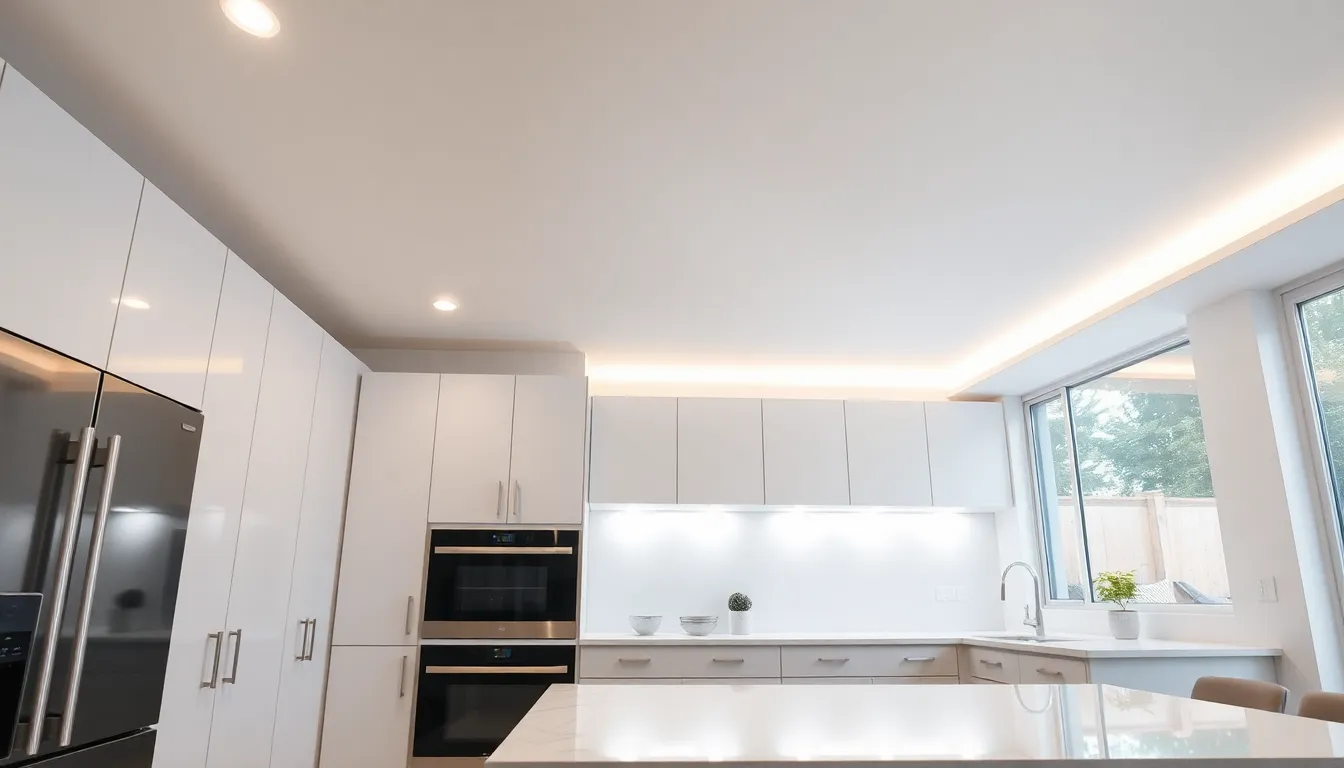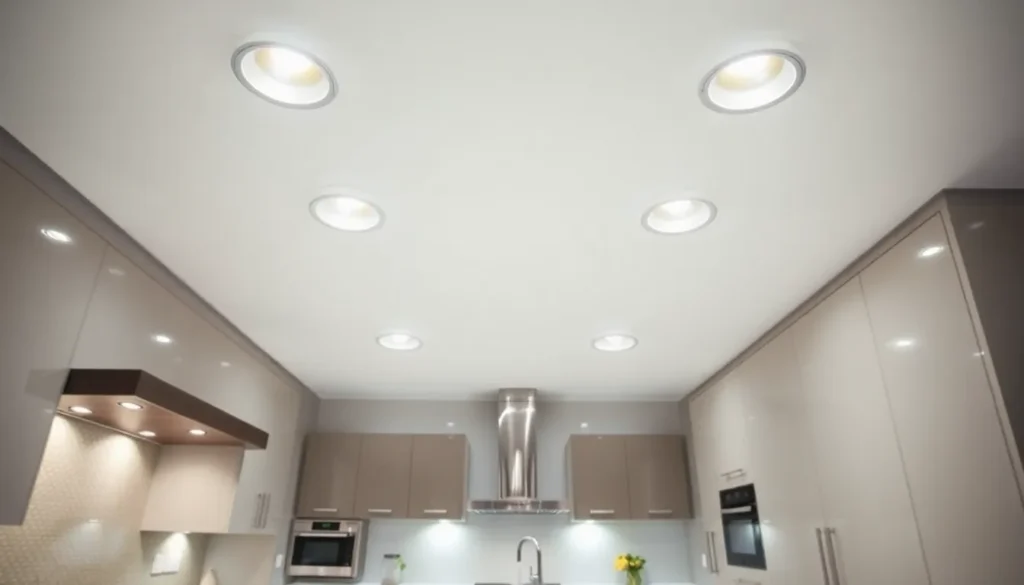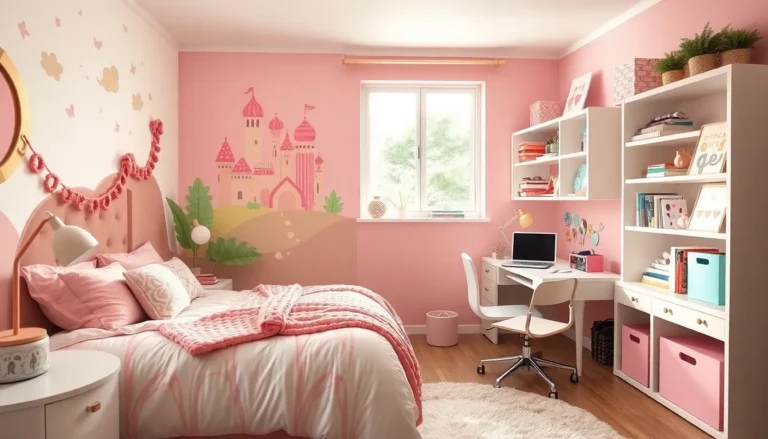Recessed lighting has become a popular choice for homeowners and designers alike, transforming spaces with its sleek and modern appeal. These fixtures, often referred to as can lights or pot lights, provide a clean, unobtrusive way to illuminate any room. With their ability to blend seamlessly into ceilings, recessed lights not only save space but also create a sophisticated atmosphere.
As more people seek to enhance their home environments, understanding the benefits and applications of recessed lighting is essential. From accentuating architectural features to providing task lighting, these fixtures offer versatility that suits various styles and needs. Whether it’s a cozy living room or a stylish kitchen, recessed lighting can elevate the overall aesthetic while ensuring optimal brightness.
Table of Contents
ToggleOverview of Recessed Lighting
Recessed lighting consists of fixtures installed within ceilings, creating an unobtrusive lighting source. These fixtures, often called can lights or pot lights, provide uniform illumination while minimizing visible hardware. Recessed lighting serves multiple purposes, including accentuating design elements and illuminating specific areas for tasks.
Choosing recessed lighting involves several key considerations. Fixture size often varies, with standard diameters ranging from 4 to 6 inches. Light source options include LED, halogen, and incandescent bulbs, each offering different energy efficiencies and lifespans. Lumens indicate brightness levels, with many homeowners opting for 600 to 800 lumens per fixture for general lighting.
Placement and spacing are critical for optimal lighting. Typically, fixtures should be spaced 4 to 6 feet apart for even distribution. Designers frequently recommend staggered layouts to avoid shadows and provide depth. Dimmer switches can enhance flexibility, allowing users to adjust brightness based on mood or activity.
Applications of recessed lighting extend to numerous settings. Living rooms benefit from accent lighting, drawing attention to art or architectural features. Kitchens can utilize task lighting, illuminating countertops and workspaces. Bathrooms often require bright, even lighting, facilitating grooming tasks. Outdoor spaces can also feature recessed lighting, creating ambiance while enhancing safety.
With its versatility and sleek design, recessed lighting represents a popular choice for contemporary interior design, increasing both functionality and visual appeal.
Types of Recessed Lighting

Recessed lighting can be categorized based on installation methods and specific applications. Understanding these types helps in selecting the right fixtures for a project.
New Construction vs. Remodel
New construction recessed lighting is typically integrated into the initial building phase. Fixtures designed for new builds feature adjustable mounting brackets and are easier to install with accompanying electrical work. These lights are often installed in ceilings before finishing materials, ensuring clean and unobtrusive aesthetics right from the start.
Remodel recessed lighting caters to existing structures. These fixtures, also known as retrofit lights, provide a way to enhance illumination without extensive renovations. They fit into existing ceiling openings and connect to current electrical systems, making them ideal for updating spaces. Homeowners often utilize remodel lighting to improve ambiance or functionality in remodeled kitchens, living rooms, and other areas.
Retrofit Options
Retrofit recessed lighting options include kits designed to transform existing fixtures. These kits allow for energy-efficient upgrades, often converting traditional incandescent or halogen fixtures to LED technology. Retrofit kits usually consist of a new LED module and a trim that fits into the existing housing, enhancing brightness and reducing energy consumption without altering the overall ceiling structure.
Various styles and finishes are available in retrofit options, catering to different design preferences. Homeowners can choose from adjustable, baffle, or reflector trims to match their interior aesthetics while optimizing light distribution. Retrofitting offers a cost-effective solution for updating lighting without extensive construction work, making it a popular choice for many renovations.
Benefits of Recessed Lighting
Recessed lighting offers numerous advantages, making it a preferred choice for many homeowners and designers. Its integration into ceilings enhances both functionality and design aesthetics.
Aesthetic Appeal
Recessed lighting creates a sleek and sophisticated look in any room. By minimizing visible hardware, it maintains clean lines and a modern vibe. These fixtures can highlight architectural features, adding depth and interest to spaces. Adjustable fixtures allow homeowners to direct light where needed, enhancing surfaces and focal points. Whether used in living rooms, kitchens, or bathrooms, recessed lighting elevates ambiance while ensuring a streamlined appearance throughout various interior styles.
Space-Saving Solutions
Recessed lighting effectively maximizes ceiling height and visual space. Unlike traditional light fixtures, which can disrupt sightlines and take up valuable headroom, recessed lights fit snugly into the ceiling. This characteristic benefits small or low-ceilinged rooms, creating an illusion of spaciousness. Homeowners appreciate this solution in tight areas like hallways or compact kitchens, where functionality and style meet without compromising space. With careful placement, recessed lights illuminate without overwhelming the design, making them perfect for modern interiors.
Installation Considerations
Proper installation of recessed lighting ensures optimal performance and aesthetics. Key factors include wiring and electrical requirements, as well as placement and spacing.
Wiring and Electrical Requirements
Wiring and electrical considerations are crucial for recessed lighting installation. Installers must conform to local building codes and electrical standards. Use 14-gauge wire for circuits that support up to 15 amps, while 12-gauge wire accommodates up to 20 amps. Ensure the circuit can handle the total wattage of all fixtures combined. Incorporate dimmer switches when choosing dimmable lights, as they enhance functionality. It’s essential to have a licensed electrician evaluate the electrical system, particularly for remodel installations or when upgrading to LED fixtures.
Placement and Spacing
Placement and spacing dictate the effectiveness of recessed lighting. For general lighting, spaces typically range from 4 to 6 feet apart. In larger areas, increase spacing to maintain even illumination and minimize shadows. Stagger the layout rather than aligning fixtures in a straight line, which promotes uniform light distribution. Position fixtures to direct light towards focal points, such as artwork or architectural features, enhancing ambiance. Consider furniture and room usage; ensure recessed lights are not obstructed and avoid direct glare on surfaces, ensuring a comfortable lighting experience.
Energy Efficiency and Technology
Recessed lighting continues to evolve with advancements in energy efficiency and technology. Homeowners benefit from reduced energy consumption and enhanced control over their lighting environments.
LED Recessed Lighting
LED recessed lighting represents a significant advancement in energy efficiency. These fixtures consume 75% less energy than incandescent bulbs, while lasting up to 25 times longer. The typical wattage for LED options ranges from 6 to 15 watts, providing ample brightness equivalent to 60-100 watt incandescent bulbs. Additionally, LED recessed lights emit less heat, decreasing air conditioning costs during warmer months. Many options feature adjustable brightness levels and color temperature settings, allowing users to customize ambient lighting from warm to cool tones.
Smart Lighting Solutions
Smart lighting solutions integrate technology into recessed lighting, offering numerous advantages. Smart recessed lights connect to Wi-Fi or Bluetooth, enabling control through mobile apps or voice-activated devices. Users can schedule on/off times, adjust brightness, and change colors based on preferences. Energy monitoring features allow users to track consumption, promoting further savings. Integration with home automation systems enhances efficiency and convenience, as homeowners can control lighting from anywhere, reducing unnecessary energy use when away from home.
Recessed lighting stands out as a versatile and stylish option for modern homes. Its ability to blend seamlessly into ceilings while providing effective illumination makes it a favorite among homeowners and designers alike. The advancements in energy efficiency and smart technology further enhance its appeal, allowing for customization and convenience. With proper installation and thoughtful placement, recessed lighting not only elevates the aesthetic of a space but also improves functionality. As homeowners continue to seek innovative lighting solutions, recessed lighting is likely to remain a top choice for creating inviting and dynamic environments.



